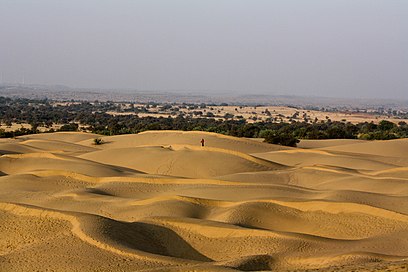Marusthali: Unterschied zwischen den Versionen
Aus Yogawiki
Keine Bearbeitungszusammenfassung |
Keine Bearbeitungszusammenfassung |
||
| Zeile 3: | Zeile 3: | ||
Der indische Teil der [[Thar Marusthal|Wüste Thar]] (Große Indische Wüste) wird ebenfalls als ''Marusthali'' bezeichnet. | Der indische Teil der [[Thar Marusthal|Wüste Thar]] (Große Indische Wüste) wird ebenfalls als ''Marusthali'' bezeichnet. | ||
https://upload.wikimedia.org/wikipedia/commons/thumb/9/92/Thar_desert_Rajasthan_India.jpg/408px-Thar_desert_Rajasthan_India.jpg | |||
https://upload.wikimedia.org/wikipedia/commons/thumb/6/6d/Khejri.jpg/450px-Khejri.jpg | https://upload.wikimedia.org/wikipedia/commons/thumb/6/6d/Khejri.jpg/450px-Khejri.jpg | ||
https://upload.wikimedia.org/wikipedia/commons/thumb/b/be/1-IMG_0117_01.JPG/375px-1-IMG_0117_01.JPG | https://upload.wikimedia.org/wikipedia/commons/thumb/b/be/1-IMG_0117_01.JPG/375px-1-IMG_0117_01.JPG | ||
Aktuelle Version vom 21. Februar 2024, 11:15 Uhr
Marusthali (Sanskrit u. Hindi: मरुस्थली maru-sthalī f.) wörtl.: "Wüsten-Land" (Maru-Sthali); Wüste, Wüstenei, Sandöde.
Der indische Teil der Wüste Thar (Große Indische Wüste) wird ebenfalls als Marusthali bezeichnet.



Eine typische Baumart der Wüste Thar ist der Shami (Prosopis cineraria).